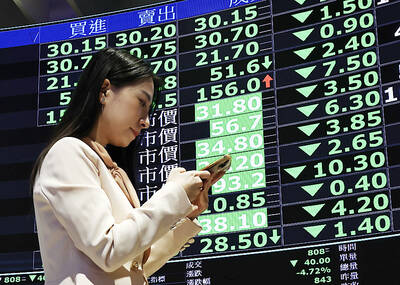Once the most famous sightseeing spot in Taiwan, the observatory on top of the nation's third highest building, the Shin Kong Tower, will close down at the end of the year after posting losses over the past two years, a company official said yesterday.
The 12-year lease contract for the observatory, located on the 46th floor, or 200m up in the tower opposite the Taipei Main Station, will expire on Dec. 31.
Wu Chuan-chuan (吳娟娟), general manager of the Shin Kong Observatory, said the business started getting in the red two years ago and has posted losses of NT$6 million (US$179,100) this year alone.
"It's the best sightseeing spot. Perhaps people have forgotten about it, and perhaps we haven't done enough marketing and advertising," Wu said.
Opened in 1994, the observatory once drew over 6,000 people a day at its peak, but traffic has drastically declined to only 100 tourists on weekdays or more than 200 on weekends.
Shin Kong Tower's halo has been snatched by the much higher Taipei 101 Observatory, located on the 89th floor of the Taipei 101 building at a height of 382.2m.
Taipei 101 has become the new favorite with traffic surging to 5,000 to 8,000 people on holidays, said Michael Liu (劉家豪), assistant vice president of Taipei Financial Center Corp (台北金融大樓公司), manager of the skyscraper.

TARIFFS: The global ‘panic atmosphere remains strong,’ and foreign investors have continued to sell their holdings since the start of the year, the Ministry of Finance said The government yesterday authorized the activation of its NT$500 billion (US$15.15 billion) National Stabilization Fund (NSF) to prop up the local stock market after two days of sharp falls in reaction to US President Donald Trump’s new import tariffs. The Ministry of Finance said in a statement after the market close that the steering committee of the fund had been given the go-ahead to intervene in the market to bolster Taiwanese shares in a time of crisis. The fund has been authorized to use its assets “to carry out market stabilization tasks as appropriate to maintain the stability of Taiwan’s

STEEP DECLINE: Yesterday’s drop was the third-steepest in its history, the steepest being Monday’s drop in the wake of the tariff announcement on Wednesday last week Taiwanese stocks continued their heavy sell-off yesterday, as concerns over US tariffs and unwinding of leveraged bets weighed on the market. The benchmark TAIEX plunged 1,068.19 points, or 5.79 percent, to 17,391.76, notching the biggest drop among Asian peers as it hit a 15-month low. The decline came even after the government on late Tuesday authorized the NT$500 billion (US$15.2 billion) National Stabilization Fund (國安基金) to step in to buoy the market amid investors’ worries over tariffs imposed by US President Donald Trump. Yesterday’s decline was the third-steepest in its history, trailing only the declines of 2,065.87 points on Monday and

TAKING STOCK: A Taiwanese cookware firm in Vietnam urged customers to assess inventory or place orders early so shipments can reach the US while tariffs are paused Taiwanese businesses in Vietnam are exploring alternatives after the White House imposed a 46 percent import duty on Vietnamese goods, following US President Donald Trump’s announcement of “reciprocal” tariffs on the US’ trading partners. Lo Shih-liang (羅世良), chairman of Brico Industry Co (裕茂工業), a Taiwanese company that manufactures cast iron cookware and stove components in Vietnam, said that more than 40 percent of his business was tied to the US market, describing the constant US policy shifts as an emotional roller coaster. “I work during the day and stay up all night watching the news. I’ve been following US news until 3am

Six years ago, LVMH’s billionaire CEO Bernard Arnault and US President Donald Trump cut the blue ribbon on a factory in rural Texas that would make designer handbags for Louis Vuitton, one of the world’s best-known luxury brands. However, since the high-profile opening, the factory has faced a host of problems limiting production, 11 former Louis Vuitton employees said. The site has consistently ranked among the worst-performing for Louis Vuitton globally, “significantly” underperforming other facilities, said three former Louis Vuitton workers and a senior industry source, who cited internal rankings shared with staff. The plant’s problems — which have not